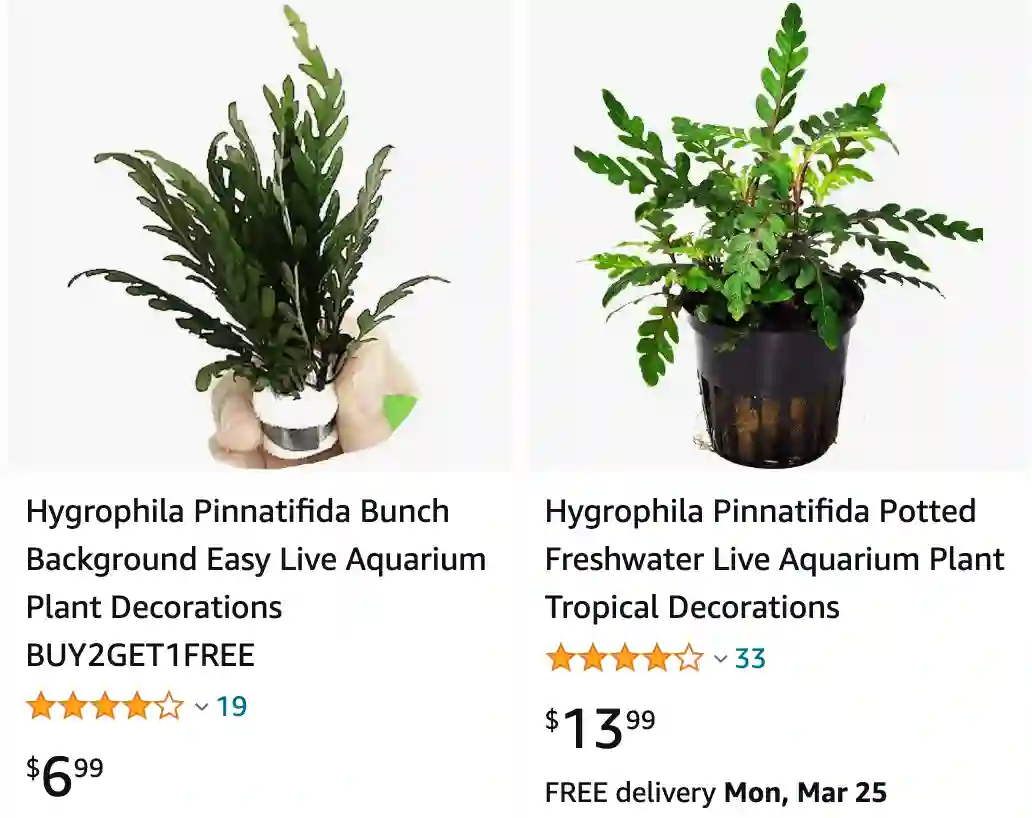
Does Hygrophila pinnatifida need CO2?
From my experience with Hygrophila pinnatifida, I found that while CO2 isn’t absolutely necessary for it to grow, it definitely thrives and looks much better with added CO2. When I didn’t use CO2, the growth was slower and the leaves weren’t as vibrant. But once I started injecting CO2, the plant’s overall health and appearance improved significantly, making it a much more attractive addition to my aquarium.
How to plant Hygrophila pinnatifida?
There are two main ways to plant Hygrophila pinnatifida in your aquarium:
1. Substrative Planting:
This method involves planting the stem directly into the substrate like other aquatic plants. Here’s a step-by-step guide:
- Choose a healthy stem: Select a healthy stem with good growth and no signs of disease.
- Bunch trimming (optional): If the stem is very bushy, you can trim some of the lower leaves to encourage better stem growth in the substrate.
- Planting depth: Make a small hole in the substrate deep enough to accommodate the lower portion of the stem (typically 1-2 inches). Gently insert the stem into the hole and carefully push the substrate around the base to secure it upright.
- Weighting (optional): For some substrates or particularly bushy stems, you can use a small piece of slate or plant weight to hold the stem down until the roots establish themselves.
2. Epiphytic Planting:
This method treats Hygrophila pinnatifida like an epiphyte, attaching it to driftwood, rocks, or other aquarium decorations. Here’s how to do it:
- Material selection: Choose a clean and dry piece of driftwood, rock, or decoration for attachment.
- Attachment method: There are a few ways to secure the stem to the chosen material:
- Fishing line: Gently tie the stem to the chosen object using a thin fishing line. Once the plant establishes itself, the fishing line can usually be removed.
- Plant weights: Attach the stem to the object using a commercially available plant weight designed for aquatic plants.
- Super glue (with caution): A small dab of cyanoacrylate gel super glue can be used to secure the stem to the object. However, use this method with extreme caution and only a tiny amount of glue, ensuring no glue comes in contact with the water.
Aftercare for both methods:
- Lighting: Ensure your aquarium has good lighting. Hygrophila pinnatifida thrives under bright, indirect light.
- Water parameters: Maintain good water quality with a neutral to slightly acidic pH (6.0-7.5) and a temperature range between 68-82°F (20-28°C).
- Nutrients: Consider adding CO2 supplementation and occasional liquid fertilizer to promote healthy growth, especially if your aquarium has limited nutrients.
- Trimming: Regularly trim overgrown stems to maintain a desired shape and encourage bushier growth.
Additional Tips:
- Hygrophila pinnatifida is a fast grower and can benefit from regular trimming to prevent it from taking over the aquarium.
- Planting the stems in groups can create a more natural and visually appealing look.
- If you notice any yellowing or melting leaves, it could indicate insufficient light, nutrient deficiencies, or excessive water flow. Adjust your aquarium parameters accordingly.
How to trim Hygrophila pinnatifida?
Trimming Hygrophila pinnatifida was something I had to learn to do regularly to keep it looking its best. I usually trim the tops to encourage bushier growth and prevent the plant from becoming too leggy. Whenever the stems started reaching the surface or overshadowing other plants, I would cut them back, which also allowed me to propagate new plants from the trimmings.
Do you need to plant Hygrophila pinnatifida?
I decided to plant Hygrophila pinnatifida because I wanted a versatile and unique-looking plant in my aquarium. Its distinctive leaf shape and the potential for interesting growth patterns made it a great choice. Plus, it adds a nice variety to the tank, contrasting well with other plant types. If you’re looking for something different that can adapt to various conditions, I’d say it’s worth adding to your collection.
Does Hygrophila pinnatifida need substrate?
In my setup, Hygrophila pinnatifida seemed to do fine with just a regular substrate, but I’ve read that it can grow well on hardscapes like rocks and driftwood too. Personally, I had it rooted in a nutrient-rich substrate, which seemed to support strong growth. However, given its adaptability, I’m confident it would thrive in different settings as long as it gets enough nutrients.
How to grow Hygrophila pinnatifida out of water?
Growing Hygrophila pinnatifida out of water was an interesting experiment for me. I set up an emersed tank with high humidity and good light, and the plant transitioned surprisingly well. It developed slightly different characteristics, with thicker, more robust leaves. This setup was a bit more challenging to maintain, but it was rewarding to see how adaptable the plant is.
How to propagate Hygrophila pinnatifida?
Propagating Hygrophila pinnatifida turned out to be quite simple. I would cut off healthy stems with a few leaves and replant them in the substrate. Each cutting developed roots fairly quickly and started growing on its own. This made it easy to spread the plant throughout the aquarium and even share it with friends who were looking to add something unique to their tanks.




